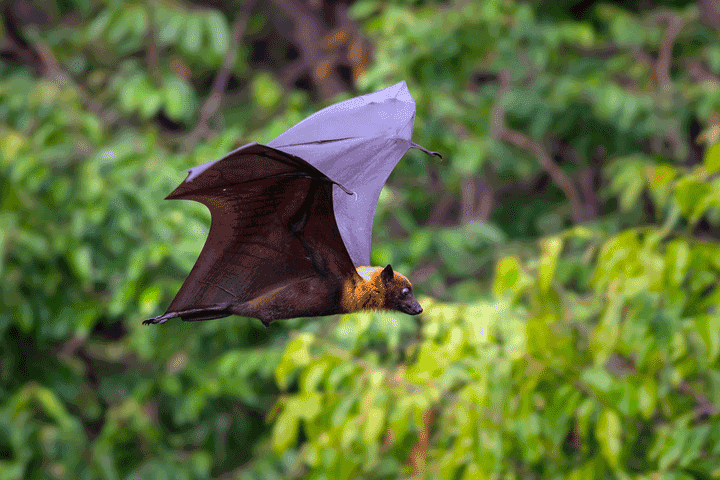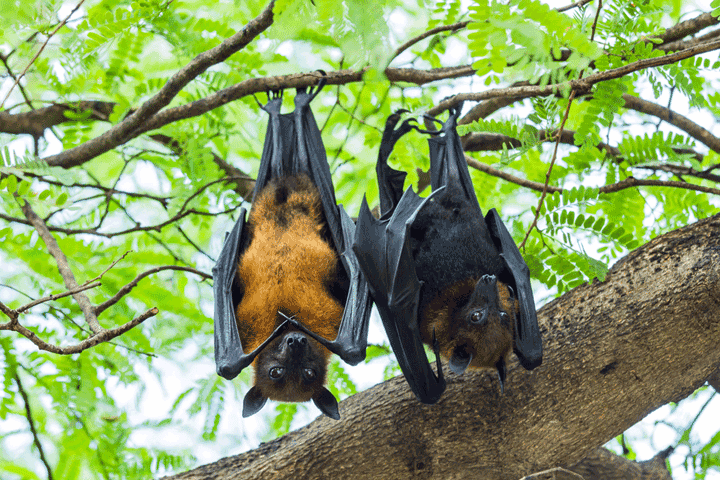Flying dogs in Thailand

Have you ever seen a dog fly? Dogs enough in here Thailand and apart from that dog, which after being beaten by a Thai owner gets a kick and flies out the door, you don't see those animals floating through the air with wings on their bodies.
Yet flying dogs do exist in Thailand, but you understand that they are not real dogs. It is a large species of bat with a wingspan between 24 and 180 cm. The head of a fruit bat does indeed resemble a dog's head, their ears are more pointed and they have larger eyes than other bats.
After a visit to his tree nursery, Joop Oosterling took us to a nearby village, where many, probably thousands of flying dogs, camped in the numerous trees in a temple complex. I used to think that bats lived in dark caves, but this species just sleeps in the foliage of these trees during the day. With too much noise, or a whistle, the colony is startled and flies away like a black cloud, only to return to their resting place shortly afterwards.

The flying dogs are not aggressive or anything and live on fruits. The mango and banana plantations often suffer from these animals, but I don't know if that is also the case with this large group. Of course the flying dogs have enemies such as tree snakes and monitor lizards, but the biggest enemies are humans themselves, who poison the flying dogs especially in fruit growing areas. Fortunately, this colony, safely under the care of the monks, does not seem to be affected.
There is more to tell about the flying dogs - which are called 'flying foxes' in English, by the way - but you can read more and watch videos of this interesting animal group on Wikipedia.


These animals are also found in Indonesia and in Java they are called KALONGS
and at BALI MALOGS. They are attracted to ripe fruits that sometimes fall to the ground.
In my youth I picked up these fruits on the ground.
Sometimes these kalongs are caught to show to tourists.
I have seen them several times at Wat Pho Bang Khla in Bang Khla. Visited from Chachoengsao. This temple is located 17 km from the city along highway no.304 (Chachoengsao-Kabin route) and another 6 km along highway 3121.
A great sight especially when they start flying and the complex is well worth it. There is an old Viharn built between 1767-1772 that fell into disrepair and was renovated in 1942. Something was built over it so that the old Viharn has been preserved. There are also beautiful Buddha statues in the complex.
The flying fox, bats pollinate the durian..
That is why the flower is also open for pollination at night.
Many bats get entangled in nets placed over fruit trees to protect the harvest.
https://www.theguardian.com/environment/radical-conservation/2018/feb/19/durian-flying-fox-bats-pollination-pollinators-deforestation-hunting-conservation
They are beautiful animals. It's a shame that the Thai people eat them again. In Nongkay they are just on the morning market. Costs there are THB 80 per kg.
Jan
It is a pity that in the Netherlands they eat deer, roe deer, wild boar, pheasants, rabbits, hares, partridges, pigeons...etc etc etc. …is exactly the same.
You forget to mention that many of these animals are bred to eat, and are therefore not threatened with extinction at all. The flying dog, on the other hand….is not the same at all!
As I understand these bats are as important for pollination of fruit bearing trees as the bees. It may be known that the bees have recently been threatened in their survival. Only these bats, with their flights of up to 50 km per night, also take the seeds with them and defecate them again, which also ensures the important distribution of tree species over considerable distances.
Incidentally, while bird species fly with the bone equivalent of what our arms are, these bats only fly with their finger bones. and that sometimes with a wingspan of up to 1.80. Strong fingers.
We have a house in Phuket and sit on our terrace in the evening to enjoy the flying dogs that fly over every evening.
One day we decided to count them and there were more than 1000 pieces.
We don't want them to come into our garden, so there won't be a whole plant left, but it will still be a great sight.
And thanks for the beautiful photos.
Just a little more work and we can enjoy it again.
Sincerely
Sylvia
Beautiful beasts unfortunately also threatened by the greatest predator, man
Lately there are also whole swarms flying over here in takhli against the seemstering. That is recent: waterfowl used to fly over in the evening
However, these animals are also known to spread disease. The corona 19 virus may also come from the bat.
Rabies is one of the diseases they can contribute.
After a bit better try to get to a hospital very quickly.
5 injections needed or when you have passed the first 3 in the Netherlands (as recommended) 2 extra in Thailand.
My wife immediately said, when she saw the photo, oh nice!. Maybe that explains why you see them less (or isn't it?).
They were caught with nets by her father.